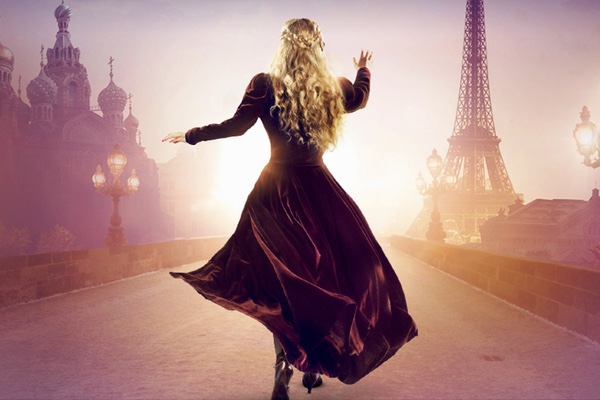Murdering the Tsar and His Family – Set to Music

Everybody knows the story of Anastasia, the daughter of Tsar Nicholas II and his wife Alexandra Hesse-Darmstadt, the rulers of Russia until the 1917 Bolshevik revolution. The Bolsheviks murdered the couple and their five children, it seemed. Then word dribbled out, here and there, that pretty little Anastasia had somehow escaped and was hiding in Russia, sought by her grandmother, the Dowager Empress and Tsar’s mother, who was in Paris.
Ten different young women arrived at the Dowager Empress’s house, all claiming to be Anastasia. Then a special girl, Anya, turned up. Anya said she had amnesia but knew things no one but the princess could know. She had a royal diamond, like the ones all knew the Tsar’s daughters had secretly sewn into their clothing before they were shot. She remembered private royal nicknames only those in the inner circle knew. But was she the real Anastasia or a fraud?
The story of the missing Princess (a Grand Duchess, actually) was told and retold in movies, books and media articles numerous times over the years and became worldwide folklore. The woman with the best claim to the young Grand Duchess’s title, Anna Anderson, even filed a lawsuit in courts in Germany that was dismissed after a 32 year long series of hearings. Finally, in 2007, forensics scientists, armed with DNA tests, compared Anderson’s DNA to the bloodline of the Romanovs and said there was not even a remote chance that Anderson was the Princess. The little Princess, they swore, was gunned down in the summer of 1918 with all the other members of the Royal Family.
The new Broadway musical Anastasia, that opened last night at New York’s Broadhurst theater, on W. 44th street, tells the story again, and the result is a dazzling tale, one of the best musicals of the year, a historical thriller and a sure-fire multiple Tony nominee.
Anastasia has a book by Terrence McNally and is directed by the gifted Darko Tresnjak (with superb choreography by Peggy Hickey). The play’s music is by Stephen Flaherty and Lynn Aherns. Collectively, they have staged a memorable musical.
The play opens in St. Petersburg, Russia, as the Bolsheviks are taking over. A series of shells explode outside of the Tsar’s palace and, in short order, the Communists win the war and execute the royal family. The missing Princess rumor surfaces. Two con men decide to hoodwink the world by backing a fake Anastasia. They turned away numerous actresses who try out for the hoax role and then bump into Anya, the girl with amnesia who seems to know a lot about the Romanovs. Could she be the Princess? They train her and get her ready to for the big meeting with the Dowager Empress in Paris.
The show is based on the 1990s animated movie but looks more like a big, lustrous Broadway show than an animated film. The music is lovely as is the sharp choreography. The big hit from the 1990s movie, Journey to the Past, has been kept and ends act one to a thunderous roar from the audience. Other tunes are good, too, and they help set the stage for both Anya’s romance and for the setting of the sun on the Romanov Empire in Paris.
The sets for the play are beautiful. At one point, set designer Alexander Dodge builds a theater, with a ballet in progress, within the confines of the Broadhurst Theater. His work is impressive. He designed street scenes, palace ballrooms and rural woods galore. He built a railroad car that ambles across stage with a film background to make it appear it is traveling at high speed. Enormous vivid color phots of Paris and St. Petersburg fill the stage as backdrops at different points.
The main actors in the musical are terrific, led, of course, by Christie Altomare as the truly impressive Anastasia. Other fine performances are given by Mary Beth Peil as the Dowager Empress, Caroline O’Connor as the Empress’s lady in waiting, Constantine Germanacos as Count Ipolitov, Ramin Karimloo as Gleb, Derek Klena as Dimitry and John Bolton as Vlad. They are joined by a large ensemble of actors who double up on various roles and, as a group, provide sensational singing.
One historically accurate and rather interesting aspect of the play is the treatment of the royals who somehow got out of Russia when the revolution broke out. They took their families and their money and fled mostly to Paris. They established their own little empire there, staying pretty close to each other. This was all done far from the history exploding all over the place in Russia at the time. They are there and yet they are not there, just as the director shows the Tsar and his wife, always in a hazy ghostly light.
The history in the play is pretty good but, as in many history plays, takes liberties. Anna Anderson’s story is not really fleshed out and the other Anastasia imposters are ignored. The whole meeting between Anastasia and the Empress is murky. Some events are pretty much on target and some fade into the mists of history. As an example, the thuggish and bloody reign of the Bolsheviks in the early days of the revolution is pretty much ignored.
Anastasia is a delight, though an out and out hit, a historical home run. See it.
PRODUCTION: The show is produced by Stage Entertainment, Bill Taylor, Tom Kirdahy, Hunter Arnold, the Shubert Organization, others. Sets: Alexander Dodge, Costumes: Linda Cho, Lighting: Donald Holder, Sound: Peter Hylenski, Projection Design: Aaron Rhyne. Choreography: Peggy Hickey. The play is directed by Darko Tresnjak. It has an open ended run.